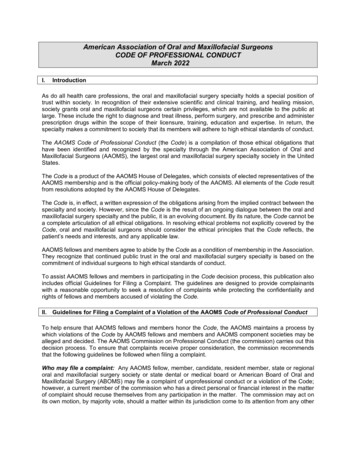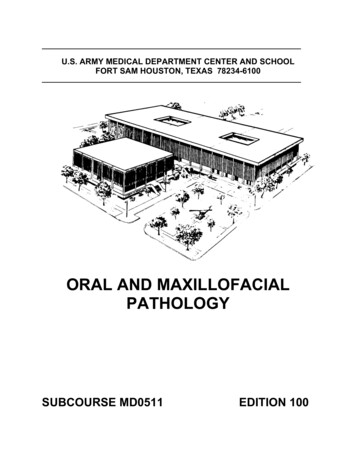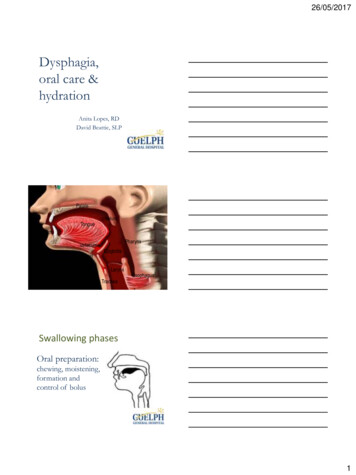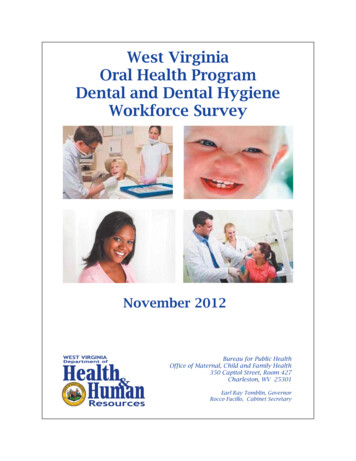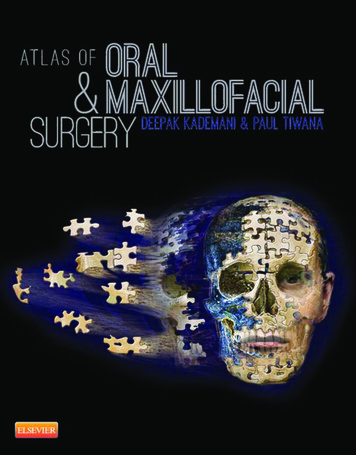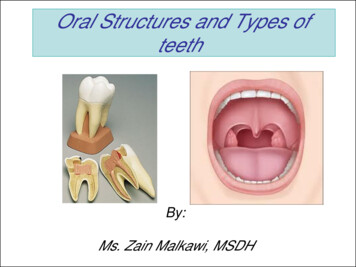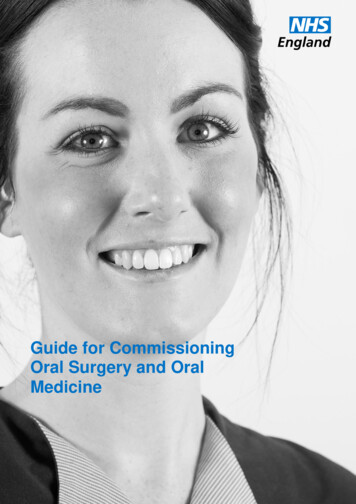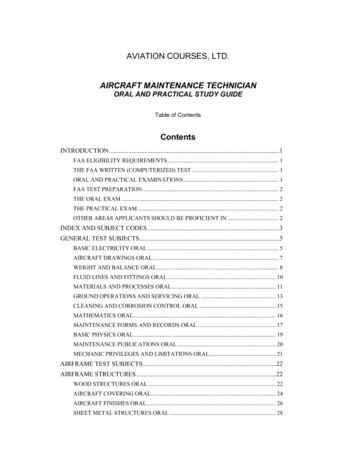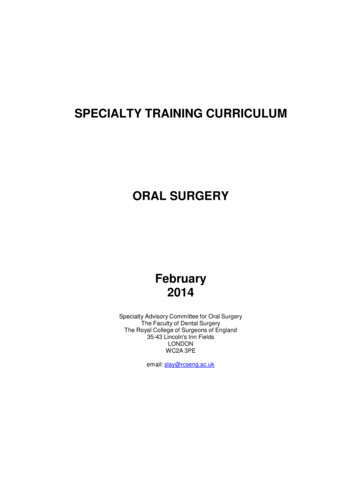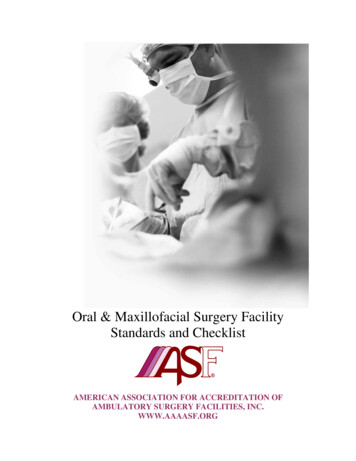
Transcription
Oral & Maxillofacial Surgery FacilityStandards and ChecklistAMERICAN ASSOCIATION FOR ACCREDITATION OFAMBULATORY SURGERY FACILITIES, INC.WWW.AAAASF.ORG
5/2018
AMERICAN ASSOCIATION FORACCREDITATION OFAMBULATORY SURGERY FACILITIES, INC.Oral & Maxillofacial Surgery Facility Standards and Checklist forAccreditation of Ambulatory Surgery FacilitiesVersion 2 August 2011 2011 Revised Publication 2010American Association for Accreditation of Ambulatory Surgery Facilities, Inc.1
2
TABLE OF CONTENTSPage #5Facility IdentificationCurrent Staff Identification7The AAAASF OMS Surgery Facility Accreditation Program13Definition of Facility Classes17Oral and Maxillofacial StandardsSection #100 General Environment23200 Procedure Room Policy, Environment and Procedures28300 Post Anesthetic Procedure Recovery Area39400 General Safety in the Facility45500 IV Fluids and Medications50600 Medical Records55700 Quality Assessment, Quality Improvement62800 Personnel67900 Anesthesia75Answer Sheets3
4
The AAAASF Oral & Maxillofacial Surgery Facility Accreditation ProgramThe American Association for Accreditation of Ambulatory Surgery Facilities, Inc. (AAAASF) conducts anaccreditation program that verifies that a facility meets nationally recognized safety standards. Theprocedural facility accreditation program is conducted by physicians and nurses who determine thestandards under the direction of a Board of Directors. The Oral & Maxillofacial facility accreditation isintended for ambulatory facilities performing procedures under sedation which would include oral &maxillofacial surgeons, and others. The AAAASF strives for the highest standards of excellence for itsfacilities by regularly revising and updating its requirements for patient safety and quality of care.Basic Mandates Patients receiving anesthetic agents other than topical or local anesthesia should be supervised in theimmediate post discharge period by a responsible adult for at least 12-24 hours, depending on theprocedure and anesthesia used.Changes in facility ownership must be reported to the AAAASF Office within thirty (30) days of thechange.Any death occurring in an accredited facility, or any death occurring within thirty (30) days of a procedureperformed in an accredited facility, must be reported to the AAAASF office within five (5) business daysafter the facility is notified or otherwise becomes aware of that death. In addition to this notification, thedeath must also be reported as an unanticipated procedure sequela in the semi-annual Peer Reviewreport. In the event of a death occurring within thirty (30) days of a procedure done in an AAAASFaccredited facility, an unannounced inspection may be done by a senior inspectorThe facility director is responsible for establishing and enforcing policies that protect patients. Thedirector monitors all members of the medical and facility staff for compliance with this policy.AAAASF Patient Rights should be posted, followed and promoted.All individuals using the facility must meet one of the following criteria (throughout this document theterms, medicine and medical apply to all M.D., D.M.D, D.O, and D.D.S. degrees):1. A physician certified or eligible for certification by one of the member boards of the American Boardof Medical Specialties (ABMS).2. A Doctor of Dental Medicine or Dental Surgery certified or eligible for certification by the AmericanBoard of Oral and Maxillofacial Surgery (ABOMS). All oral and maxillofacial surgeons practicing in an AAAASF accredited facility must hold, or mustdemonstrate that they have held, unrestricted hospital privileges in their specialty at an accredited and/orlicensed acute care hospital within thirty (30) minutes of the accredited facility for all procedures that theyperform within the facility. Only procedures included in those hospital privileges may be performedwithin the AAAASF accredited facility. An oral and maxillofacial surgeon must be present whenanesthesia other than strictly local is being administered in Class B, Class C-M or Class C accreditedfacilities.If pediatric patients are treated in the facility, a minimum of one staff member who is PALS certified(Pediatric Advanced Life Support Course), must be present in the facility until all pediatric patientsrecovering from anesthesia have met criteria for discharge from the facility.The aesthetic procedures performed by Oral & Maxillofacial surgeons that are permitted by state andfederal regulations and laws, and are also performed by Board Certified Plastic Surgeons,Otolaryngologists and Dermatologists must follow the applicable standards in the AAAASF RegularStandards Manual.Failure to adhere to the basic mandates of AAAASF will result in referral to the InvestigationsCommittee. Sanctions by the Board of Directors may result in emergency suspension and revocation.5
The following list of OMS Office-Based procedures are permitted under this current version of theAAAASF Oral & Maxillofacial Facility Standards. The AAAASF Board of Directors reserves theright to review and edit these procedures at any time based upon differing scopes of practicestandards, and changing state and federal regulations and laws.DentoalveolarExtractions – simple and complexAlveolectomy/AlveoplastyPeriapical Surgery (Apicoectomy)Hard & Soft Tissue GraftingHarvest & PlacementLocal and DistantXenograftAllograftAutograftPlacement of Dental ImplantsTraumaHard & Soft Tissue TraumaLacerationsFractures – Closed and Open ReductionDental including AvulsionPain Management – head and neckOrthognathic & EstheticAlloplastic ImplantsSliding GenioplastyRemoval of HardwareEsthetic procedures as delineated by State-designated Scope ofPracticePathologyHard & Soft Tissue Biopsy and ExcisionSalivary Duct and GlandOdontogenic and Non-Odontogenic Lesions of the JawsSinus & NoseGraftingClosure of Oro-Antral and Oro-Nasal CommunicationCaldwell-LucManagement of InfectionsHard & Soft TissueOdontogenicTMJ Arthrocentesis and ArthroscopyAddendum May 2010: And any other procedure as encompassed by the American Dental Association's definition of the specialty ofOral and Maxillofacial Surgery, subject to that which is allowed under a state's legally-defined scope of practice for either dentistryor Oral and Maxillofacial Surgery.6
Onsite InspectionA facility is inspected every three years. The facility inspector will review any deficiencies with the facilitydirector and forward the Standards and Checklist answer sheet to the AAAASF Central Office. To beaccredited by AAAASF, a facility must meet every standard for its Class (A, B, C-M or C).Onsite Inspection Privacy PolicyOnsite AAAASF Inspections typically involve the attention of the facility Medical Director, the anesthesiaprovider, and the facility staff working intently with the AAAASF surveyor(s). The inspection process mustremain focused, and therefore, AAAASF has directed that equipment representatives not be present duringAAAASF’s announced or unannounced inspections/surveys. Accreditation consultants may be presentduring the surveys; however AAAASF asks that consultants remain silent during the inspection process untilit is completed. All AAAASF surveyor(s) have the authority to request any participants to leave theinspection process if interference becomes a problem. AAAASF greatly appreciates the cooperation of allconcerned parties by complying with this directive.Self-Evaluation InspectionA facility is evaluated by the facility director each year between inspections, and the Standards and Checklistanswer sheet is sent to the AAAASF Office. A facility’s AAAASF accreditation remains valid if it continuesto meet every standard for its Class (A, B, C-M or C). Otherwise, accreditation is revoked.7
Denial or Loss of AccreditationThe AAAASF will deny or revoke accreditation of a facility if the facility fails to satisfy every standard for itsClass (A, B, C-M or C), or if any Oral and Maxillofacial Surgeons performing procedures at the facility that: Has had their privileges to perform procedures restricted or limited by any hospital at which the oraland maxillofacial surgeon has privileges, related to lack of clinical competence, ethical issues, orprofessional problems other than economic competition.Has been found to be in violation of the Code of Ethics of any professional medical society orassociation of which they are a member.Has had their right to practice medicine, and/or dentistry limited, suspended, terminated orotherwise affected by any state, province, or country, or if they have been disciplined by any medicaland/or dentistry licensing authority.Non-reporting of any of the above to the AAAASF.HearingAny facility whose accreditation has been revoked or denied by the AAAASF has the right to a Hearing atwhich it may present information to show that it has satisfied the requirements for accreditation. TheHearing process is described in the AAAASF Bylaws, available from the AAAASF Central Office.Emergency Suspension or Emergency ProbationThe AAAASF may place a facility on Emergency Suspension or Emergency Probation status upon receivinginformation that a state medical or dental board has taken action, or begun formal proceedings which mayresult in it taking action against a license held by an oral & maxillofacial surgeon practicing at the facility, orthe Board of Directors determining that the facility may no longer meet AAAASF standards foraccreditation. A facility that has been placed on Emergency Suspension or Emergency Probation status willremain in such status pending an investigation and possible Hearing, conducted in accordance withAAAASF procedures that are available from the AAAASF Central Office.8
Definition of AAAASF Facility ClassesClass A:In a Class A Facility, all surgical, endoscopic and/or pain management procedures may be performed underthe following anesthesia:1. Topical Anesthesia2. Local Anesthesia If oral medications are used, only minimal and moderate sedation levels are permitted in Class AFacilities. Class A Facilities must meet all Class A standards.Class B: In a Class B facility, all oral and maxillofacial surgical or dental procedures may be performed underthe following anesthesia:1. Topical Anesthesia2. Local Anesthesia3. Parenteral Sedation4. Regional Anesthesia5. Dissociative Drugs (excluding Propofol) Agents 3 through 5 may be administered by:-An AnesthesiologistAn appropriately credentialed Oral and Maxillofacial Surgeon or Dental AnesthesiologistA Certified Registered Nurse Anesthetist (CRNA) under physician supervision ifrequired by state or federal law, or by policy adopted by the facilityAn Anesthesia Assistant (as certified by the National Commission for the Certificationof Anesthesiologist Assistants) under direct supervision of an AnesthesiologistRegistered Nurses, only under the supervision of a qualified Oral and MaxillofacialSurgeon The use of Propofol, Spinal Anesthesia, Epidural Anesthesia, Endotracheal Intubation Anesthesia,Laryngeal Mask Airway Anesthesia, and/or Inhalation General Anesthesia (including Nitrous Oxide)are prohibited in a Class B facility Class B facilities must meet all Class A and Class B standards.9
Class C-M:In a Class C-M facility, all oral and maxillofacial surgical or dental procedures may be performed under thefollowing anesthesia:1. Topical Anesthesia2. Local Anesthesia3. Parenteral Sedation4. Regional Anesthesia5. Dissociative Drugs (including propofol) Agents 3 through 5 may be administered by:- An Anesthesiologist- An Appropriately credentialed Oral and Maxillofacial Surgeon or DentalAnesthesiologist- A Certified Registered Nurse Anesthetist (CRNA) under physician supervision ifrequired by state or federal law, or by policy adopted by the facility- An Anesthesia Assistant (as certified by the National Commission for the Certificationof Anesthesiologist Assistants) under direct supervision of an Anesthesiologist- Registered Nurses, (excluding Propofol) under the supervision of a qualified Oral andMaxillofacial Surgeon Propofol anesthesia may be administered only by:- A Certified Registered Nurse Anesthetist (CRNA) under physician supervision ifrequired by state or federal law, or by policy adopted by the facility- An Anesthesiologist- An appropriately credentialed Oral and Maxillofacial Surgeon or Dental Anesthesiologist The use of Spinal Anesthesia, Epidural Anesthesia, Endotracheal Intubation Anesthesia, LaryngealMask Airway Anesthesia, and/or Inhalation General Anesthesia (including Nitrous Oxide) isprohibited in a Class C-M facility. Class C-M facilities must meet all Class A, Class B and Class C-M standards.10
Class C:In a Class C facility all oral and maxillofacial surgical or dental procedures may be performed under thefollowing anesthesia:1. Topical Anesthesia2. Local Anesthesia3. Parenteral Sedation4. Regional Anesthesia5. Nitrous Oxide6. Dissociative Drugs (including Propofol)7. General Anesthesia (with or without Endotracheal Intubation or Laryngeal MaskAirway Anesthesia) Agents 3 through 5 may be administered by:- An Anesthesiologist- An Appropriately credentialed Oral and Maxillofacial Surgeon or DentalAnesthesiologist- A Certified Registered Nurse Anesthetist (CRNA) under physician supervision ifrequired by state or federal law, or by policy adopted by the facility- An Anesthesia Assistant (as certified by the National Commission for the Certificationof Anesthesiologist Assistants) under direct supervision of an Anesthesiologist- Registered Nurses, (excluding Propofol) under the supervision of a qualified Oral andMaxillofacial Surgeon Propofol and agents 6 and 7 may be administered only by:- An Anesthesiologist- An appropriately credentialed Oral and Maxillofacial Surgeon or Dental Anesthesiologist- A Certified Registered Nurse Anesthetist (CRNA) under physician supervision ifrequired by state or federal law or by policy adopted by the facility- An Anesthesia Assistant (as certified by the National Commission for the Certificationof Anesthesiologist Assistants) under the direct supervision of an AnesthesiologistClass C facilities must meet all Class A, Class B, Class C-M and Class C standards. 11
Important NoticeMaximal patient safety has always been our guiding concern. We are proud that our Standards may beconsidered the strongest of any agency that accredits ambulatory surgery facilities, and that many considerthem to be the Gold Standard. We recognize, however, that they need to be part of a living document, and wecontinually re-evaluate and revise these Standards in the light of medical advances and changing legislativeguidelines.The AAAASF Accreditation Program requires 100% compliance with each Standard to become and remainaccredited. There are no exceptions. However, when a Standard refers to appropriate or proper or adequate,reasonable flexibility and room for individual consideration by the inspector is permitted as long as patientand staff safety remain uncompromised.DefinitionAdequate – is meant to encompass size, space, maintenance, cleanliness, free of clutter, lighting,appropriately equipped, etc.The facility director must attest that the facility meets all local, state, and federal regulations, since suchgovernmental regulations may supersede AAAASF Standards. Please note, however, that the stricterregulation applies, whether it is the federal, state, local, or AAAASF standard.Please complete and sign the following Facility Director’s Attestation document and return it to theAAAASF office.12
The following Standards are the property of the American Association For Accreditation of AmbulatorySurgery Facilities, Inc. Unauthorized use is prohibited.Copyright 2011 American Association For Accreditation of Ambulatory Surgery Facilities, Inc. Allrights reserved.AAAASF7500 Grand Ave Suite 200Gurnee, IL 60031-2986Toll-free: 888-545-5222Phone: 847-775-1970Fax: 847-775-1985Web: www.aaaasf.orgFOR THE SURVEYOR VERSION ONLYEach Standard Question Must Have a Response!If a standard for the Class (A, B, C-M or C) does not apply to the situation in this facility, indicate such bymarking N/A on the answer sheet.Each numbered Standard question in this booklet must have a response. If a Standard for a facility does notapply to the situation in the facility, the inspector must indicate such by marking N/A on the answer sheet.For every N/A, there must be an explanation noted by the inspector on the answer sheet to justify thatresponse. All NO answers should be discussed with the facility director or appropriate staff, and theinspector should make recommendations as to how the deficiencies should be corrected.13
14
Oral and Maxillofacial Standard Version 2100BASIC MANDATES100.10Basic Mandates100.010.015A,B,C-M,CPatients receiving anesthetic agents other than topical or local anesthesia should be supervised in theimmediate post discharge period by a responsible adult for at least 12-24 hours, depending on the procedureand anesthesia used.100.010.020A,B,C-M,CChanges in facility ownership must be reported to the AAAASF Office within thirty (30) days of the change.100.010.025A,B,C-M,CAny death occurring in an accredited facility, or any death occurring within thirty (30) days of a procedureperformed in an accredited facility, must be reported to the AAAASF office within five (5) business days afterthe facility is notified or otherwise becomes aware of that death. In addition to this notification, the deathmust also be reported as an unanticipated procedure sequela in the semi-annual Peer Review report. In theevent of a death occurring within thirty (30) days of a procedure done in an AAAASF accredited facility, anunannounced inspection may be done by a senior inspector.100.010.027A,B,C-M,CAAAASF Patient Rights should be posted, followed and promoted.100.010.030A,B,C-M,CAll individuals using the facility must meet one of the following criteria (throughout this document the terms,medicine and medical apply to all M.D., D.M.D, D.O, and D.D.S. Degrees):1. A physician certified or eligible for certification by one of the member boards of the American Board ofMedical Specialties (ABMS).2. A Doctor of Dental Medicine or Dental Surgery certified or eligible for certification by the AmericanBoard of Oral and Maxillofacial Surgery (ABOMS).15
Oral and Maxillofacial Standard Version 2100100.010.032BASIC MANDATESA,B,C-M,CThe facility director is responsible for establishing and enforcing policies that protect patients. The directormonitors all members of the medical and facility staff for compliance with this policy.100.010.035A,B,C-M,CAll oral and maxillofacial surgeons practicing in an AAAASF accredited facility must hold, or mustdemonstrate that they have held, unrestricted hospital privileges in their specialty at an accredited and/orlicensed acute care hospital within thirty (30) minutes of the accredited facility for all procedures that theyperform within the facility. Only procedures included in those hospital privileges may be performed within theAAAASF accredited facility. An oral and maxillofacial surgeon must be present when anesthesia other thanstrictly local is being administered in Class B, Class C-M or Class C accredited facilities.100.010.040A,B,C-M,COnsite AAAASF Inspections typically involve the attention of the facility Medical Director, the anesthesiaprovider, and the facility staff working intently with the AAAASF surveyor(s). The inspection process mustremain focused, and therefore, AAAASF has directed that equipment representatives not be present duringAAAASF‟s announced or unannounced inspections/surveys. Accreditation consultants may be present duringthe surveys; however AAAASF asks that consultants remain silent during the inspection process until it iscompleted. All AAAASF surveyor(s) have the authority to request any participants to leave the inspectionprocess if interference becomes a problem. AAAASF greatly appreciates the cooperation of all concernedparties by complying with this directive.100.010.045AClass A:In a Class A Facility, all surgical, endoscopic and/or pain management procedures may be performed underthe following anesthesia:1. Topical Anesthesia2. Local Anesthesia If oral medications are used, only minimal and moderate sedation levels are permitted in Class AFacilities. Class A Facilities must meet all Class A standards.16
Oral and Maxillofacial Standard Version 2100100.010.050BASIC MANDATESA,BClass B: In a Class B facility, all oral and maxillofacial surgical or dental procedures may be performed under thefollowing anesthesia:1. Topical Anesthesia2. Local Anesthesia3. Parenteral Sedation4. Regional Anesthesia5. Dissociative Drugs (excluding Propofol) Agents 3 through 5 may be administered by: An Anesthesiologist An appropriately credentialed Oral and Maxillofacial Surgeon or Dental Anesthesiologist A Certified Registered Nurse Anesthetist (CRNA) under physician supervision if requiredby state or federal law, or by policy adopted by the facility An Anesthesia Assistant (as certified by the National Commission for the Certification ofAnesthesiologist Assistants) under direct supervision of an Anesthesiologist Registered Nurses, only under the supervision of a qualified Oral and MaxillofacialSurgeon The use of Propofol, Spinal Anesthesia, Epidural Anesthesia, Endotracheal Intubation Anesthesia,Laryngeal Mask Airway Anesthesia, and/or Inhalation General Anesthesia (including Nitrous Oxide) areprohibited in a Class B facility Class B facilities must meet all Class A and Class B standards.17
Oral and Maxillofacial Standard Version 2100100.010.055BASIC MANDATESA,B,C-MClass C-M:In a Class C-M facility, all oral and maxillofacial surgical or dental procedures may be performed under thefollowing anesthesia:1. Topical Anesthesia2. Local Anesthesia3. Parenteral Sedation4. Regional Anesthesia5. Dissociative Drugs (including propofol) Agents 3 through 5 may be administered by: An Anesthesiologist An Appropriately credentialed Oral and Maxillofacial Surgeon or Dental Anesthesiologist A Certified Registered Nurse Anesthetist (CRNA) under physician supervision if requiredby state or federal law, or by policy adopted by the facility An Anesthesia Assistant (as certified by the National Commission for the Certification ofAnesthesiologist Assistants) under direct supervision of an Anesthesiologist Registered Nurses, (excluding Propofol) under the supervision of a qualified Oral andMaxillofacial Surgeon Propofol anesthesia may be administered only by: A Certified Registered Nurse Anesthetist (CRNA) under physician supervision if requiredby state or federal law, or by policy adopted by the facility An Anesthesiologist An appropriately credentialed Oral and Maxillofacial Surgeon or Dental Anesthesiologist The use of Spinal Anesthesia, Epidural Anesthesia, Endotracheal Intubation Anesthesia, Laryngeal MaskAirway Anesthesia, and/or Inhalation General Anesthesia (including Nitrous Oxide) is prohibited in aClass C-M facility. Class C-M facilities must meet all Class A, Class B and Class C-M standards.18
Oral and Maxillofacial Standard Version 2100100.010.060BASIC MANDATESA,B,C-M,CClass C:In a Class C facility all oral and maxillofacial surgical or dental procedures may be performed under thefollowing anesthesia:1. Topical Anesthesia2. Local Anesthesia3. Parenteral Sedation4. Regional Anesthesia5. Nitrous Oxide6. Dissociative Drugs (including Propofol)7. General Anesthesia (with or without Endotracheal Intubation or Laryngeal MaskAirway Anesthesia) Agents 3 through 5 may be administered by: An Anesthesiologist An Appropriately credentialed Oral and Maxillofacial Surgeon or Dental Anesthesiologist A Certified Registered Nurse Anesthetist (CRNA) under physician supervision if requiredby state or federal law, or by policy adopted by the facility An Anesthesia Assistant (as certified by the National Commission for the Certification ofAnesthesiologist Assistants) under direct supervision of an Anesthesiologist Registered Nurses, (excluding Propofol) under the supervision of a qualified Oral andMaxillofacial Surgeon Propofol and agents 6 and 7 may be administered only by: An Anesthesiologist An appropriately credentialed Oral and Maxillofacial Surgeon or Dental Anesthesiologist A Certified Registered Nurse Anesthetist (CRNA) under physician supervision if requiredby state or federal law or by policy adopted by the facility An Anesthesia Assistant (as certified by the National Commission for the Certification ofAnesthesiologist Assistants) under the direct supervision of an Anesthesiologist Class C facilities must meet all Class A, Class B, Class C-M and Class C standards.19
Oral and Maxillofacial Standard Version 2200PROCEDURE ROOM POLICY, ENVIRONMENT AND PROCEDURES200.10Policy200.010.010B,C-M,CA policy for a „procedure pause‟ or a „time out‟ protocol is in place and practiced prior to every procedure.This protocol should include:Pre-procedure verification process to include medical records and imaging studies to be reviewed by theprocedure room team. Missing information or discrepancies must be addressed at this time.Marking the procedure site where appropriate –Side/Site identification will comply with the Universal Protocol standards for oral and maxillofacial surgicaland/or dental procedures.‘Time Out’ immediately before starting the procedure Conduct a final verification by at least two (2) members of the procedure team confirming the correct patient,procedure, site marking(s) and, as applicable, special equipment or requirements. As a ‘fail-safe’ measure, theprocedure is not started until any and all questions or concerns are resolved.200.20200.020.005EnvironmentA,B,C-M,CThe facility displays a professional appearance in keeping with an Oral and Maxillofacial Surgery facilitydesigned to carry out procedures. The facility should be neat, comfortable and clean and should include awaiting area, business office and sanitary lavatory facilities. One or more dedicated exam rooms should beavailable that provide for privacy and treatment in a sanitary, orderly environment.200.020.010B,C-M,CThere is a room dedicated for use as a procedure room200.020.015AAn exam room may function as a procedure room.20
Oral and Maxillofacial Standard Version 2200200.020.020PROCEDURE ROOM POLICY, ENVIRONMENT AND PROCEDURESA,B,C-M,CThe procedure room(s) is adequately ventilated and temperature controlled.200.020.025A,B,C-M,CThere is adequate storage space to hold equipment, supplies and medications. Storage space should beadequate to minimize the need to leave the procedure room for frequently used supplies, equipment and/ormedications.200.020.030A,B,C-M,CStorage space provides easy access for identification and inventory of supplies.200.020.035A,B,C-M,CThe procedure room(s) is properly cleaned, maintained and free of litter and clutter.200.020.040A,B,C-M,CEach procedure room is of a size adequate to allow for the presence of all equipment and personnel necessaryfor the performance of the procedures, and must comply with applicable local, state or federal requirements.There must be ample clear space on each side of the procedure table to accommodate emergency personneland equipment in case of emergency, and permit the safe transfer of the patient to a gurney for transport.Facility personnel can physically demonstrate to the inspector that the emergency criteria, as stated above, canbe met in the procedure room space available.200.020.045A,B,C-M,CThere are no overloaded wall plugs or extension cords in use, no altered grounding plugs in use, and wires arenot broken, worn or unshielded.200.020.050B,C-M,CUnauthorized individuals are deterred from entering the procedure room by locks, alarms, or facility personnel.21
Oral and Maxillofacial Standard Version 2200200.020.055PROCEDURE ROOM POLICY, ENVIRONMENT AND PROCEDURESA,B,C-M,CSterile supplies are stored away from potential contamination in closed cabinets/drawers or if not, away fromheavy traffic areas.200.020.060A,B,C-M,CSterile supplies are labeled to indicate sterility, and are packaged and sealed to prevent accidental opening.200.020.065A,B,C-M,CEach sterilized pack is marked with the date of sterilization. When more than one autoclave is available, eachpack must be labeled to identify in which autoclave it was sterilized.200.020.070A,B,C-M,CIf one sink is used both for dirty instruments and to scrub for procedures, there is a written policy to clean anddisinfect the sink prior to scrubbing hands.200.30200.030.010Procedures - SterilizationA,B,C-M,CThe facility has at least one autoclave which uses high pressure steam and heat, or all sterile items are single usedisposable.200.030.015A,B,C-M,CGas sterilizers and automated endoscope reprocessors (AER) must be vented as per CAll instruments used in patient care are sterilized, where applicable.22
Oral and Maxillofacial Standard Version 2200200.030.035PROCEDURE ROOM POLICY, ENVIRONMENT AND PROCEDURESA,B,C-M,CMonitoring records are retained for the sterilization or other disinfection process and should be reviewed andstored for a minimum of three (3) years.200.030.040A,B,C-M,CA weekly spore test, or its equivalent, is performed on each autoclave and the results filed and kept for three(3) years. The sterility of each load in the autoclave is checked with indicator tape, chemical monitors, or othereffective means both on the outside and inside of the pack.200.030.045A,B,C-M,CIf a spore test is positive, there is a protocol for remedial action to correct the sterilization process.23
Oral and Maxillofacial Standard Version 2200PROCEDURE ROOM POLICY, ENVIRONMENT AND ent handling and reprocessing areas are cleaned and maintained.200.040.015A,B,C-M,CThere is strict segregation of dirty procedure equipment and instruments that
Board of Oral and Maxillofacial Surgery (ABOMS). All oral and maxillofacial surgeons practicing in an AAAASF accredited facility must hold, or must demonstrate that they have held, unrestricted hospi
